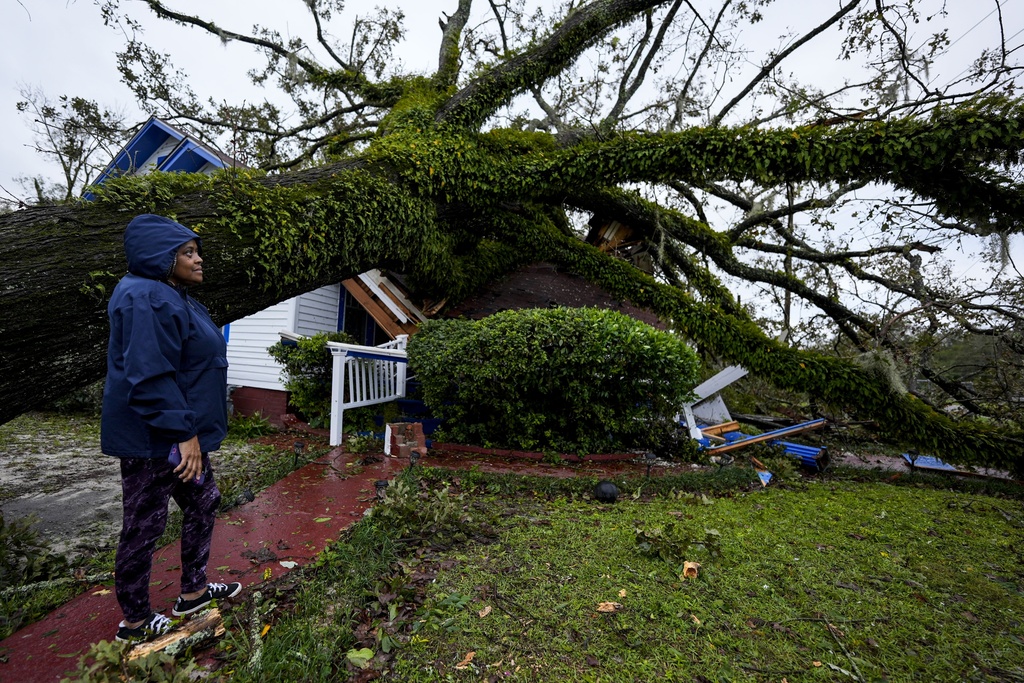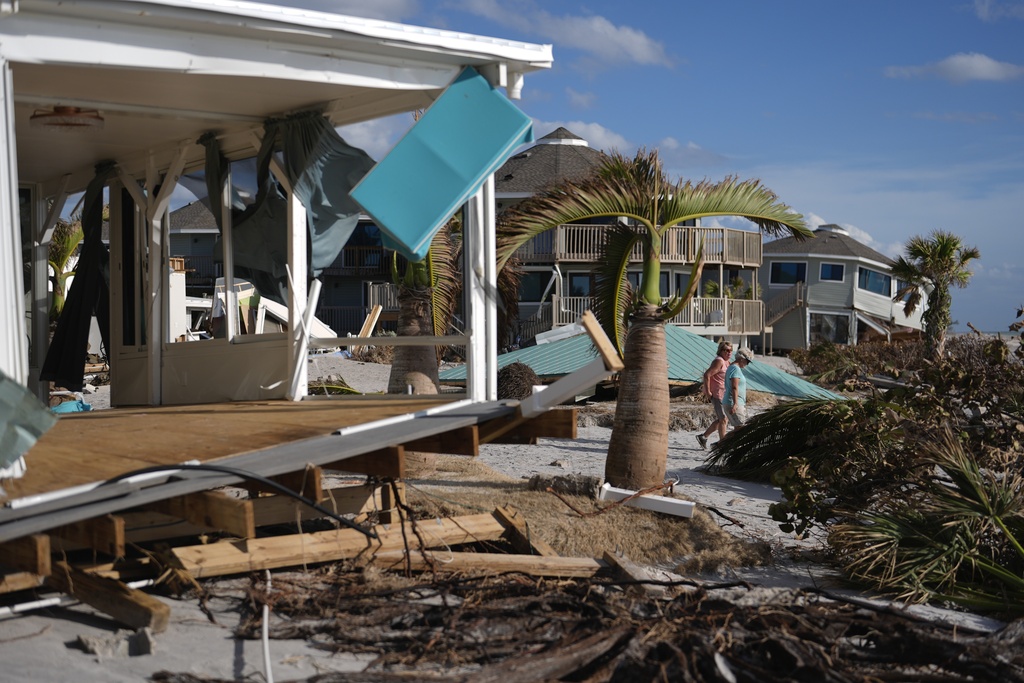Experts Warn $50 Billion Loss from Uninsured Hurricane Damage \ Newslooks \ Washington DC \ Mary Sidiqi \ Evening Edition \ Hurricanes Helene and Milton have caused widespread devastation, with damages potentially surpassing $50 billion. Most of the losses from these storms were uninsured, highlighting a critical issue as climate change intensifies hurricanes. Experts say rising costs, inadequate insurance coverage, and the need for a “managed retreat” from high-risk areas are becoming urgent societal challenges.

Hurricanes Helene and Milton: Quick Looks
- Costly Impact: Experts predict damages from Hurricanes Helene and Milton could reach $50 billion or more, placing them among the costliest storms like Katrina, Sandy, and Harvey.
- Insurance Shortfalls: Approximately 95% of Helene’s damages were uninsured, revealing a significant gap in coverage, particularly for flood-related losses.
- Climate Change Influence: Increasingly intense and wetter hurricanes, attributed to climate change, are causing higher damages, even as human casualties from such storms decline.
- Experts’ Concern: The storms reignite discussions on “managed retreat,” where communities may need to consider relocating from high-risk areas rather than repeatedly rebuilding.
Deep Look
Hurricanes Helene and Milton Expected to Join List of Costliest U.S. Storms
The twin impacts of Hurricanes Helene and Milton have left a trail of destruction that experts predict could elevate their status to the ranks of the most expensive storms in U.S. history, alongside Katrina, Sandy, and Harvey. Preliminary estimates suggest that the damages from these storms could exceed $50 billion, a financial toll aggravated by the fact that most of the affected properties were uninsured, particularly for flood damage.
Unprecedented Levels of Uninsured Losses
A troubling aspect of the hurricanes’ aftermath is the staggering amount of uninsured damage. According to John Dickson, president of Aon Edge Insurance Agency, over 95% of the damage caused by Hurricane Helene was not covered by insurance, leaving victims in dire financial straits. “Today’s storms are vastly different from those of the past,” Dickson said. “The energy content these systems can retain is significantly greater, and society is struggling to keep pace.”
Dickson’s observations underscore a grim reality: while storms are growing stronger and wetter due to climate change, the level of insurance coverage has not kept up. The rising cost of rebuilding after such storms, along with climate-induced changes, has created a perfect storm of challenges for both homeowners and insurers.
The Rising Costs of Hurricanes
The National Oceanic and Atmospheric Administration (NOAA) reports that over the past 45 years, the United States has experienced 396 weather disasters, each causing at least $1 billion in damage. Of these, 63 were hurricanes or tropical storms. Adjusted for inflation, the financial burden from these natural disasters has surged, driven by a combination of rising construction costs, increased development in high-risk areas, and climate change effects.
Adam Smith, an economist and meteorologist at NOAA, believes that Helene and Milton are on track to join the exclusive list of U.S. hurricanes that have caused more than $50 billion in damages. “The $50 billion mark for direct losses is a threshold that differentiates truly historic events,” Smith said, noting that there have been only eight hurricanes in U.S. history to reach that level.
The first such storm was Hurricane Andrew in 1992, which was followed by a 13-year gap before Katrina set new records in 2005. Since then, storms of this magnitude have become more frequent, with Helene and Milton potentially marking seven major hurricanes in just the past seven years.
Calculating Damage: A Complex Process
Determining the total damage from hurricanes like Helene and Milton is a complex and time-consuming process. These storms caused a mix of wind and flood damage across various states, spreading devastation over wide areas. For instance, Helene caused significant flooding in regions unaccustomed to such events, while Milton brought a combination of wind and rain damage.
Three Categories of Damage:
- Insured Damage: Losses covered by insurance, primarily for wind-related damage.
- Uninsured Damage: Losses not covered by any insurance, often related to flooding.
- Total Economic Cost: The combined financial impact, including uninsured losses, disruptions to infrastructure, and more.
Homeowners typically have coverage for wind damage, but flood damage requires separate insurance, which many do not have. Helene was primarily a flood event, making it less likely for victims to have adequate coverage, whereas Milton brought a mix of wind and water damage, making insurance claims slightly more feasible.
A Grim Snapshot of Insurance Coverage
A report by insurance giant Swiss Re showed that insured damage from the top 10 costliest hurricanes accounted for only 44% of total costs. For Helene, John Dickson of Aon estimated that only 5% of the damage was insured, with losses possibly ranging from $100 billion to $200 billion. For Milton, insured losses were estimated at $50 billion to $60 billion, further illustrating the vast gap between damages and coverage.
The Role of Climate Change
Experts agree that climate change is exacerbating the severity of hurricanes. Basic physics explains that warmer air holds more moisture, leading to storms that are wetter and more intense. Susan Cutter, co-director of the Hazards Vulnerability and Resilience Institute at the University of South Carolina, noted, “Economic losses are rising because we’re putting more infrastructure and housing in harm’s way, and climate change is also playing a role.”
The trend of increasing rainfall during storms is consistent with predictions made by climate scientists. According to Karen Clark, founder of disaster modeling firm Karen Clark and Company, “There is scientific agreement that floods from these hurricanes are becoming more frequent and severe. It’s not just an insurance issue—it’s a societal and political question.”
Rethinking Rebuilding and Insurance
The repeated pattern of building, destroying, and rebuilding in hazardous areas has sparked discussions on the concept of “managed retreat,” where communities may need to consider relocating rather than continuing to reconstruct in high-risk zones. “At what point do you say, ‘Enough is enough’?” Cutter asked, emphasizing the need for a strategic approach to managing risks.
Flood insurance has been a contentious issue, with many homeowners in vulnerable areas opting out due to high costs. However, as Karen Clark pointed out, the financial burden of recovery often falls on taxpayers. “When a storm hits, federal dollars inevitably flow into these areas to help people rebuild. Essentially, taxpayers are subsidizing people living in high-risk zones.”
Looking Ahead: The Future of Disaster Management
The need for effective disaster management strategies is more critical than ever. Hurricanes Helene and Milton have highlighted the need for stronger building codes, better insurance products, and proactive measures to mitigate the impact of future storms. According to Moody’s risk modeling, the combined damages from these two storms could range from $20 billion to $34 billion, while Karen Clark and Company estimate insured losses of $36 billion for Milton alone.
Ultimately, the future will require a coordinated effort among policymakers, insurers, and communities to address these escalating risks. Managed retreat, improved infrastructure planning, and stricter enforcement of insurance requirements are just a few of the strategies that experts suggest could help mitigate the impacts of future storms.
Experts Warn Experts Warn Experts Warn Experts Warn







